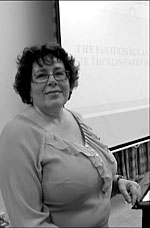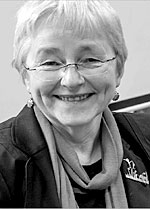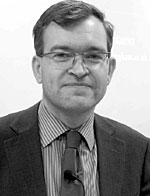Events and excursions, Winter 2013-14
The Nottingham History Lecture, 8 November 2013: Lizbeth Powell - The Ties That Bind; The Emotional Landscape of Sir Thomas Parkyns of Bunny

Before a very full audience, which included residents of Sir Thomas Parkyns’ Bunny, Lizbeth Powell explored a set of potentially new and exciting ways of looking at the lives of early-modern people though the life and connections of Sir Thomas.
This paper forms a set of initial ideas derived from Lizbeth’s doctoral studies, currently being conducted at Nottingham Trent University. At the outset, Lizbeth stated that her aim was to try and understand Sir Thomas through an exploration of his emotions. This idea is based upon an assertion by Keith Thomas that individuals in the seventeenth and eighteenth centuries were emotionally fully developed and sought fulfilment. That said exploring emotion is no easy task and the paper was largely confined to the attempt to use the written expressions of emotion which Parkyns has left us in his writings. Letters to family members, to friends, clients and associates such as John Bley of East Leake and London, formed the source material for this exploration. The changes in the way Sir Thomas felt about family members is charted through the way he dealt with debts owed within the family, but also the rather unpleasant way in which he tried to manipulate the emotions of his granddaughter in an apparently successful attempt to get her to sacrifice any ambitions that she might have, and become his housekeeper. Even so in other letters there is evidence that Sir Thomas did see his granddaughter in less utilitarian terms and cared for her emotional state of mind. Moreover, Lizbeth argued convincingly that the relationships in which Parkyns played a central role far exceeded the mechanical concerns of finance and real-estate.
The paper was followed by a lively question and debate session which reflected the audience’s fascination with, and knowledge of, the ‘wrestling’ baronet as well as Lizbeth’s innovative and enlightening approach. A version of the paper will be included in Transactions Vol. 117.
Martyn Bennett
New Thoughts on the Construction of the Great Pilgrimage Cathedral of Santiago de Compostella, 11 January 2014. Dr. Jenny Alexander

A change is as good as a rest and the lecture series departed from its usual emphasis on Nottinghamshire to do something more exotic by going abroad to the cathedral of Santiago de Compostela in north-west Spain in the company of Dr Jenny Alexander. Jenny is no stranger to the Thoroton Society having talked to us in the past on Thurgarton Priory and Lincoln cathedral. Much of her work has been concentrated on buildings in the East Midlands but, as part of a large project funded by the regional government of Galicia, Jenny was invited to bring her immense knowledge of masons’ marks to bear on the many masons’ marks found in the cathedral to carry out a survey of them in order to contribute to a greater understanding of the building.
Jenny began by explaining that in the 9th century the rediscovery of the relics of St James led to the building of a new church which was destroyed by the Moors in 997. In 1075 a new church was begun. In 1105 the five radiating east-end chapels were consecrated, and the rest of the church was said to have been consecrated in 1128. Work continued into the later 12th century. Documentary evidence was poor but two masons in particular were mentioned, Bernard the elder and Esteban (Stephen), of whom little else was known and equally which parts of the church they had built. Indeed the construction of the church has been much debated. The plan of the church was very well thought out: not only was the nave and choir aisled but the transepts as well which created space for the vast number of pilgrims to circulate. The galleries above the aisles were thus wide and well lit. Jenny told us that modern pilgrims still follow a well prescribed route: first by placing a hand in a hole in the masonry of the magnificently carved 12th-century Pórtico da Gloria, then making their way through the church to the high altar and up the stairs to go behind the statue of St James which is then hugged. The actual relics of St James are in the crypt where can be seen the substructure of the 9th-century church which itself is built on the site of much earlier Roman buildings and burials.
The number of pilgrims created problems for Jenny and she found she and her team could only work in the quieter winter months thus time was rather limited. She decided to concentrate on the east end where there were a mass of masons’ marks but here there was a major difficulty in that internally the east end had been heavily ‘baroque-ed’, as she put it, in the 17th century which obscured quite a lot of the masonry.
Nevertheless, she was able to tell that something had gone on here through breaks in the masonry and other construction oddities. External examination of the east end made difficult crowded as it is by other buildings confirmed her initial assessment. Rigorous recording of the mason’s marks and developing computer techniques for their analysis enabled her to make a number of suggestions. Masons’ marks indicate how the mason built and how he thought. She identified at least two masons. One employed a kind of ‘flatpack’ approach and the other an entirely different one. Although she could suggest which mason had built what there were still problems in the build because of as yet unidentified factors which complicated matters and to join up the dots as it were some phases had to be surmised for the time being. More work would have to be undertaken. So Jenny’s ‘new thoughts’ were that the building of the east end was not necessarily as smoothly continuous as previously thought and that perhaps there was an attempt to re-model the east end perhaps to improve the interior aesthetic and provide better lighting for the shrine and sanctuary. What may have been intended at Compostela was perhaps reflected by comparison with the east end of another pilgrimage church, the abbey of Ste Foy at Conques in France. A number of major churches built on the pilgrimage routes (caminos) to Compostela were imitations to a lesser degree of the church at Compostela and Conques abbey was such a one. The east end at Conques with only three radiating chapels was much more satisfactory: the external and internal aesthetic more harmonious and the interior space of the sanctuary comparatively very well lit.
Jenny’s ‘new thoughts’ on the church of Compostela were fascinating and absorbing. A complex subject was very clearly explained which members appreciated and responded to accordingly with many questions followed by enthusiastic applause. Despite difficulties caused by unsympathetic cathedral clergy and the current problems of the Spanish economy, it is to be hoped that Jenny will be able to return to Compostela in the future to continue her work and Thoroton members will have a further opportunity to hear more of her ‘new thoughts’ on this great Romanesque church.
Trevor Faulds
The Neville Hoskins lecture - 14 December 2013.
“Emma and Edward, The Wilmotts and their World”. Dr. Richard Gaunt, Associate Professor in Modern British History, University of Nottingham.

Richard opened his presentation by telling us that he was pleased to have known Neville and proud to be giving this presentation as an extension of the work that Neville has previously done, researching the background of his “second woman”. Neville’s interest had started around 1966 when he and Rosalys Coope encountered an unsigned book of sketches of rural life and set out to identify the places illustrated and, hopefully, the artist. Neville and Rosalys identified many of the places as being in North Nottinghamshire and eventually located a second sketchbook in the Bassetlaw Museum, this one being signed “EEW”, although it was still unclear whether the artist was a man or a woman. Further searching finally showed that the artist was Emma Elizabeth Wilmot, the wife of a land agent working on the Duke of Newcastle’s estate.
Richard then told us that he had picked up Neville’s work when he passed away in 2005 and continued to research and document the lives of Emma and her family. Emma, the granddaughter of Erasmus Darwin and therefore related to the great naturalist, Charles Darwin, was brought up at Breadsall Priory before marrying Edward Woolett Wilmott in 1842. Edward was older than Emma, having previouly been married to Augusta Matilda who had unfortunately died early of what was reported as a “lingering illness”. After their marriage Emma and Edward moved to Sparken House in Worksop, where they set up the family home and produced four children, one of whom died in infancy. Edward’s position as Land Agent to the Duke of Newcastle entitled him to a salary of £800 per year as well as the house, although he also owned another farm which brought in additional income from its tenant. Emma appears, therefore, to have been able to raise the family in some comfort and to indulge herself in her pastime of sketching scenes and events from their rural life.
Richard referred to Emma’s sketchbooks as ‘diaries without words’, being a record of people and places of the time and also acting as a record of many buildings that no longer survive. The source of Emma’s skill is not recorded but the two sketchbooks do show a developing expertise, with the quality of the pictures in the second, Bassetlaw, book being much better than the first. During their time at Worksop, Emma also became known as a patroness of several churches, the principal ones being at Worksop, Steetley and Thorpe Salvin.
Edward eventually had a disagreement with the Duke of Newcastle, lost his job and their home, and went to work for the Davenport Estate before taking up a position as Agent to the Buxton Estate of the Duke of Devonshire. During his time at Davenport, Edward met Elizabeth Gaskell, the novelist, and we were asked to speculate whether she used him as a model for Mr. Horner in her novella My Lady Ludlow. When the BBCproduced their television series Cranford they used characters from other Gaskell novels to supplement those in the original book and one of these, Edmund Carter, is now assumed to be Mr. Horner with a new name.
Whilst at Buxton, Edward and Emma established a new church at Burbage, still there today, with Edward as churchwarden. In 1864 Edward was sent from Buxton to Harrogate to recover from illness but eventually died and was buried in the churchyard at Burbage. Emma lived on to the grand age of 78 and when she died in 1898, she was also buried at Burbage, where a plaque still records the life and family of Edward and Emma Wilmot.
Richard closed his presentation with a number of unanswered questions from his research so far:
- What was the mysterious “lingering illness” that Edward’s first wife died from?
- Where did Emma learn to sketch so well and who taught her?
- Are there any more sketchbooks in existence that would help to fill the gaps in their lives?
- Was Edward really the model for Mr. Horner who became Edward Carter on television?
Richard’s research will continue and we were invited to help him by considering these questions whilst also perusing his book that reproduces many of Emma’s sketches.
David Hoskins
[Ed. Members will recall that Richard’s book, Emma’s Sketchbook was reviewed by Dr. Tom Smith in the Newsletter issue 72, Summer 2013 and that a picture from the book was used on the cover of that issue.]